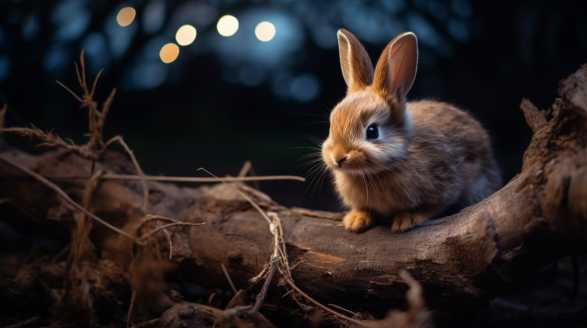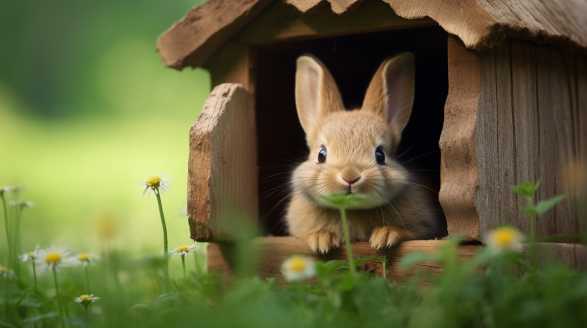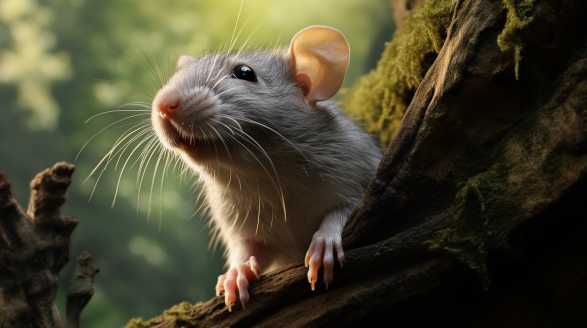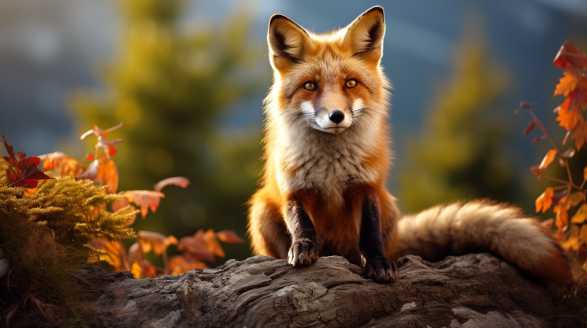Introduction
What kills rabbits at night? Let’s find out.
When darkness envelops the land, the realm of bunnies takes on a whole new level of intrigue. As a devoted wildlife enthusiast, I’ve always been fascinated by the secret lives of these adorable creatures that captivate our hearts.
we’re diving headfirst into the nocturnal ecosystem, uncovering the factors that impact rabbit survival at night. We’ll be exploring the lure of the darkness, the dangers that come with it, and the strategies rabbits employ to navigate this treacherous terrain.
But that’s not all – we’ll also be armed with knowledge and practical strategies that you can use to protect your own fluffy companions from the clutches of nocturnal predators. From fortified enclosures and predator deterrents to the importance of supervision and varying schedules, we’re going to show you how to become the ultimate guardian of your rabbits.
So, are you ready for an adrenaline-pumping adventure? Get ready to step into the nocturnal world of rabbits, where danger lurks at every turn and survival is a matter of wit and resilience.

Key Takeaways
- Nocturnal predators pose a significant threat to rabbits at night, including foxes, raccoons, owls, and more.
- Rabbits have evolved various adaptations to evade predators, such as hiding, burrowing, and having keen senses.
- Human activities, habitat destruction, and predator control also impact rabbit survival.
- Protecting rabbits from predators involves creating secure enclosures, using deterrents and lighting, and monitoring their safety.
- Weather conditions can influence rabbit predation, with rainfall providing cover and wind and moonlight increasing vulnerability.
- It is important to recognize signs of predatory attacks on rabbits, such as behavioral changes or physical injuries.
- Mitigating risks for wild rabbits includes creating safe havens, illuminating darkness, reducing human-induced hazards, and promoting community involvement.
- Protecting rabbits from nocturnal predators requires a secure habitat, predator-proof fencing, deterrents, and supervision during outdoor time.
- Varying routines and providing hiding places for rabbits, as well as securing food and water sources, can also help protect them.
- By implementing these measures, rabbit owners can ensure the safety and well-being of their beloved furry companions.
Exploring the Ecosystem at Night: Factors Impacting Rabbit Survival

As the sun sets below the horizon and darkness envelops the world, a whole new ecosystem awakens. It’s a realm that often goes unnoticed by humans, but for small creatures like rabbits, it is a matter of survival.
The Lure of the Darkness
Just like owls and bats, rabbits are creatures of the night. They possess an extraordinary ability to navigate the dimly-lit environment and have adapted to thrive during these hours.
- Protection from predators: With darkness as their ally, rabbits can escape the watchful eyes of their predators. Stealth becomes their best defense, allowing them to avoid becoming someone else’s meal.
- Abundance of food: The nighttime offers a cornucopia of food for rabbits. Grasses, twigs, and leaves that may be scarce during the day suddenly become plentiful. This enables rabbits to find sustenance to fuel their nocturnal escapades.
The Nighttime Dangers
While the night brings newfound opportunities, it also presents a myriad of challenges for rabbits. Survival in this secretive ecosystem depends on successfully navigating these hazards.
Predatory Perils
Rabbits may possess their own tricks for avoiding predators, but they are not invincible. The darkness brings out a whole host of creatures eager to take advantage of rabbits’ vulnerabilities.
- Owl onslaught: Silent and swift, owls stealthily hunt for small prey like rabbits. Their incredible hearing and razor-sharp vision make them formidable opponents in the darkness.
- Voracious foxes: Foxes are known for their stealth and cunning. They can expertly track rabbits by scent and pounce at just the right moment, giving the rabbits little chance for escape.
- Sly snakes: Snakes may lie in wait for rabbits, ready to strike when the opportunity arises. Their ability to seamlessly blend with their surroundings makes them a formidable threat to these furry mammals.
Buffers of the Night
Surviving in the nocturnal ecosystem is not an easy task, but there are certain factors that can increase a rabbit’s chances of survival.
Adaptations for the Night
To thrive in the darkness, rabbits have developed impressive adaptations over time. These adaptations allow them to effectively navigate their environment and overcome the obstacles they face.
- Keen senses: Rabbits have excellent hearing, which enables them to detect even the slightest sounds. Their large eyes provide them with exceptional night vision, allowing them to spot predators before they get too close.
- Burrow homes: Rabbits rely on their intricate burrow systems to seek refuge during the night. These underground tunnels not only allow them to escape predators but also provide protection from harsh weather conditions.
Human Impact on Rabbit Survival
While the nocturnal ecosystem has its own set of challenges, humans have introduced additional threats to rabbit survival.
- Habitat destruction: With the ever-increasing human population, natural habitats are shrinking at an alarming rate. Deforestation and urbanization leave little room for rabbits to thrive, forcing them to adapt to new environments or face extinction.
- Predator control: In some regions, humans interfere with predator populations to protect their livestock. While this may be advantageous for farmers, it disrupts the natural balance of the ecosystem and can lead to unintended consequences for rabbits.
Protecting the Nocturnal World
Recognizing the significance of the nocturnal ecosystem and understanding the challenges rabbits face is the first step toward protecting their survival.
- Conservation efforts: Initiatives that focus on preserving natural habitats and creating protected areas can provide rabbits with safe havens where they can flourish undisturbed.
- Awareness and education: Spreading awareness about the importance of the nocturnal ecosystem and the role of rabbits within it can help garner support for conservation efforts. Education can empower individuals to make informed decisions that benefit rabbit survival.
In the world of the night, rabbits are silent heroes, making their mark while most of us slumber. Exploring the factors impacting their survival sheds light on the delicate balance of the nocturnal ecosystem.
Strategies for Deterring Predator Attacks on Rabbits After Sunset

When it comes to the safety of our beloved rabbits, we all want to provide them with the best care possible. One of the biggest concerns for rabbit owners is protecting their furry friends from predators, especially after sunset when visibility is low.
So, let’s hop right in!
Understanding the Perils
Rabbits are natural prey animals, and as such, they are particularly vulnerable to predator attacks. After sunset, when most rabbits are active and predators lurk in the shadows, the risk is heightened.
Create a Secure Housing Environment
Secure Fencing
A strong and sturdy fencing system is the first line of defense to deter predators. Here are some tips to consider:
- Use a combination of welded wire or hardware cloth with small mesh size (less than an inch) to prevent predators from squeezing through gaps.
- Dig the fence at least one foot into the ground to deter predators that dig under the fencing.
- Make sure the fence is high enough, preferably at least three feet tall, to discourage predators from jumping over.
Protective Barriers
In addition to a secure fence, consider using additional protective barriers around your rabbit’s housing area, such as:
- ## Thorny plants
Plant prickly bushes or shrubs around the perimeter of the enclosure to create a natural deterrent for predators. Thorny plants like rose bushes or holly can act as an effective barrier while adding beauty to the surroundings.
- ## Predator-proof roof
Cover the top of the enclosure with a sturdy roof, such as hardware cloth or predator-resistant mesh, to prevent predators from climbing over the top.
Outdoor Lighting
Predators are more likely to approach if they can go undetected. Installing proper outdoor lighting around your rabbit’s housing area not only increases visibility but also deters potential predators.
- ## Motion sensor lights
Motion sensor lights are a great addition to your rabbit’s habitat. They are activated by movement and will illuminate the area, potentially scaring off predators.
- ## Solar-powered lights
Solar-powered lights are energy-efficient and can provide a soft glow throughout the night. They’re perfect for illuminating pathways and hiding spots around the enclosure.
Sounds and Smells
Predators rely on their senses to locate prey. By using specific sounds and smells, you can confuse and repel potential attackers.
Ultrasonic devices
Ultrasonic devices emit high-frequency sounds that are inaudible to humans but irritating to animals, including predators. These devices can be strategically placed near your rabbit’s housing area to deter them.
Predator urine
Predator urine can be an effective deterrent, as the scent signals danger to other animals. Consider using commercially available predator urine sprays to create a perimeter around your rabbit’s habitat.
Natural Repellents
Nature provides us with various substances that can be used as natural repellents. Here are some rabbit-friendly options:
- ## Citrus peels
Predators often dislike the scent of citrus. Scatter orange or lemon peels around the perimeter of your rabbit’s enclosure to create a natural barrier.
- ## Pepper sprays or flakes
Pepper sprays or flakes can irritate the noses and eyes of predators, making them less likely to approach. Sprinkle them sparingly around the area to deter potential attackers.
Nighttime Monitoring
While the above strategies can greatly enhance the safety of your rabbits, it’s essential to monitor them after sunset. Here’s what you can do:
- ## CCTV surveillance
Install a CCTV camera system around your rabbit’s housing area to keep an eye on any nocturnal visitors. Ensure the camera system has night vision capabilities for clear visibility after sunset.
- ## Watchful presence
Spending time near or within the proximity of your rabbit’s housing area after dark can help deter predators. The presence of humans or other animals can make potential attackers think twice before attempting an attack.
As responsible rabbit owners, it’s our duty to take necessary precautions to protect our furry friends from predator attacks. By implementing secure fencing, using outdoor lighting, creating deterrent sounds and smells, and utilizing natural repellents, you can substantially reduce the risk of nighttime predator attacks on your rabbits.
With these strategies in place, you can rest assured that your rabbits are well-protected even after the sun sets.
Common Causes of Rabbit Deaths During Nighttime Hours

Rabbits are adorable creatures that bring joy and charm to any home. As a rabbit enthusiast, I have come across various situations where these delightful pets unfortunately pass away during nighttime hours.
I will look into the common causes of rabbit deaths during nighttime hours, shedding light on why these tragedies occur and how we can prevent them.
Stress and Fright
Rabbits are highly sensitive animals, easily susceptible to stress and fright. Similar to humans, stress can have detrimental effects on their health, making them more vulnerable to illness or even sudden death.
Here are some reasons why stress and fright can lead to rabbit deaths:
- Loud Noises: Sudden loud noises during nighttime, such as fireworks or thunderstorms, can startle rabbits and cause immense stress. Ensure that your rabbit’s living area is quiet and insulated from external noises.
- Predator Presence: The presence of predators, like raccoons or cats, can induce fear and stress in rabbits. Secure hutches or cages with sturdy structures to keep predators at bay.
- Sudden Changes: Rabbits thrive on routine. Any sudden changes, like moving their living area or introducing new pets, can disrupt their sense of security and lead to stress-related health issues.
Health Issues
Rabbits, like any living beings, are prone to various health issues that can prove fatal if not addressed promptly. At night, some underlying health conditions may become critical, leading to rabbit deaths.
- Gastrointestinal Issues: Rabbits have sensitive digestive systems, and any disruption can lead to painful conditions such as bloating or gastrointestinal stasis. These conditions can worsen overnight, leading to sudden death. Ensure your rabbit’s diet consists of high-quality hay and fresh vegetables, and closely monitor their eating and litter box habits.
- Respiratory Infections: Respiratory infections can strike rabbits, causing symptoms such as sneezing, wheezing, or difficulty breathing. Once again, stress can exacerbate these conditions. Keep your rabbit’s living area clean and dust-free to reduce the likelihood of respiratory infections.
- Cardiovascular Problems: Rabbits may be susceptible to heart conditions, which can be particularly dangerous during the night when their body is at rest. Regular check-ups with a qualified veterinarian can help detect and manage any cardiovascular issues.
- Heat Stroke: Extreme temperatures, especially during summer nights, can cause heat stroke in rabbits. Ensure your rabbit has access to a cool and well-ventilated area, with plenty of fresh water available at all times.
Accidental Injuries
Regrettably, accidents can happen, and rabbits are not exempt from harm. During nighttime hours, when visibility is low, accidental injuries can occur more frequently.
- Falls: Rabbits are known for their agility, but a fall from a height can cause serious injury or internal damage. Ensure their living area is adequately protected with fences or netting to prevent falls.
- Getting Trapped: Rabbits are curious creatures and may find themselves in compromising situations, such as getting stuck in tight spaces or tangled in wires. Rabbit-proof your home to minimize the risk of such accidents.
- Ingesting Toxic Substances: Rabbits have a propensity for chewing on objects, and this behavior can lead to accidental ingestion of toxic substances. Keep household chemicals, plants, and medications out of reach.
Infectious Diseases
Infectious diseases can quickly spread among rabbits and result in fatal outcomes. During nighttime, when rabbits are more vulnerable due to lowered immune responses, these diseases can take hold.
- Rabbit Hemorrhagic Disease (RHD): This highly contagious disease affects the liver and other organs, causing internal bleeding. It can spread rapidly within a rabbit population and can lead to sudden death. Vaccination is crucial for preventing RHD.
- Myxomatosis: Myxomatosis is a viral disease that primarily affects wild rabbits. However, domestic rabbits can also become infected through insect bites. This disease typically causes severe respiratory distress and can be fatal. Preventive measures, such as insect control, are essential to protect rabbits.
- Pasteurellosis: Pasteurellosis is a bacterial infection that affects the respiratory system of rabbits. It can lead to severe pneumonia, making it particularly dangerous during night hours when rabbits are at rest.
Rabbit deaths during nighttime hours can be distressing and often leave us wondering about the causes behind these unfortunate events. By understanding the common risks and taking preventive measures, we can ensure the well-being and longevity of our beloved fluffy companions.
Let us cherish each moment spent with these gentle creatures and strive to provide them with the love and care they deserve, day and night.
Uncovering the Impact of Urban Environments on Rabbit Survival at Night

As a wildlife enthusiast, I have always been fascinated by the delicate balance between urban development and the survival of our furry friends. Today, I am thrilled to dig deeper into an intriguing topic that has captured my attention: the impact of urban environments on rabbit survival at night.
The Urban Rabbit Dilemma
Rabbits are known for their adaptability and resilience, but the encroachment of urban landscapes poses a significant threat to their survival. Here, in the midst of bustling cities, their challenges multiply.
1. Habitat Loss and Fragmentation
Urban development often leads to the destruction of natural habitats. As green spaces are converted into concrete jungles, rabbits find themselves squeezed into smaller pockets of land or isolated fragments.
2. Increased Exposure to Predators
The vibrant lights and noises of urban areas attract a variety of wildlife, including predators. Rabbits become more exposed to threats such as raccoons, foxes, and domestic pets, as they navigate the urban landscape.
3. Limited Access to Food and Water
The availability of abundant food sources diminishes drastically within a concrete-dominated environment. Rabbits are forced to scavenge for food, often resorting to consuming human-associated items or low-nutrient foliage.
Urban Adaptations and Strategies
Despite the challenges they face at night, rabbits have shown incredible resilience by adapting to their urban environments in various ways. Understanding their unique strategies can shed light on potential solutions to support their survival:
1. Altering Activity Patterns
To avoid potential predators and embrace the safety of darkness, rabbits have been observed altering their activity patterns. They tend to become more active during dawn and dusk rather than venturing out in the heavily human-populated areas during the night.
2. Utilizing Urban Substitutes
Green spaces within cities, such as parks and gardens, offer rabbits a substitute for their lost natural habitats. These areas provide food sources, shelter, and breeding opportunities for their continued survival.
3. Burrow Adaptations
Rabbits are well-known for their intricate burrow systems, which provide them with protection from harsh weather conditions and predators. In urban environments, they make use of small openings, such as gaps under buildings or fences, to create makeshift burrows.
Empowering Urban Rabbit Survival
To enhance the survival of rabbits in urban environments, we must recognize our role in creating a harmonious coexistence. Here are several measures we can take to support their well-being:
1. Preserving and Enhancing Green Spaces
Preservation and expansion of green spaces within cities is crucial for providing rabbits with suitable habitats. By planting native vegetation and creating interconnected green corridors, we can enhance their access to food, water, and shelter, while fostering biodiversity within urban ecosystems.
2. Implementing Wildlife-Friendly Lighting
Rabbits, like many nocturnal species, are sensitive to artificial lighting. Using wildlife-friendly lighting techniques, such as shielding light fixtures and utilizing warm-colored bulbs, can reduce light pollution and minimize its disruptive effects on their behavior and survival.
3. Reducing Chemical Use
Pesticides and herbicides in urban areas can pose significant risks to rabbits and other wildlife. Limiting the use of these chemicals and adopting alternative pest control methods, such as integrated pest management, can safeguard their health and maintain a more balanced environment.
4. Promoting Community Awareness and Education
Educating the community about the importance of preserving wildlife and creating a rabbit-friendly urban landscape is vital. By raising awareness, organizing workshops, and involving local residents in conservation efforts, we can foster a sense of stewardship and collective responsibility towards these precious creatures.
Embracing a Sustainable Future
As we look into the impact of urban environments on rabbit survival at night, we discover a mosaic of challenges and adaptations. By recognizing the importance of safeguarding their habitat, altering our own behaviors, and fostering community participation, we can create a sustainable future for rabbits and other wildlife within urban landscapes.
Let us join forces, embracing compassion and innovation, to unravel the secrets that ensure the survival of our fluffy neighbors, even in the midst of city lights. Together, we can create a world where their adorable presence continues to bring smiles and wonder to our urban lives.
The Predators That Pose a Threat to Rabbits at Night

Rabbits, those adorable fluffy creatures that hop around with innocence and grace. The world seems like a safe place for them during the day, as they nibble on grass and frolic in the sunshine.
These are the predators that pose a threat to rabbits at night, lurking in the shadows, ready to pounce. we will look into the mysterious world of nocturnal predators and uncover the dangers they bring to our fluffy companions.
1. The Cunning Fox
In the realm of night, the fox reigns supreme as one of the most intelligent and adaptable predators. Their slender bodies and keen senses make them a formidable foe for rabbits.
2. The Silent Owl
Hoo-hoo-hoo! In the cover of darkness, the owl emerges from its roost, prepared for a stealthy pursuit.
Their silent wings slice through the air as they swoop down upon unsuspecting rabbits, sending a chilling shiver down their spine.
3. The Elusive Bobcat
The forest engulfs itself in mystery as the bobcat prowls through the undergrowth, its sharp eyes gleaming against the moonlight. Its muscular physique and stealthy movements give it an upper hand in pursuing rabbits, perfectly camouflaged to blend with the darkness.
The Rabbit’s Evading Techniques
1. The Art of Hiding
Rabbits have evolved an exceptional talent for blending into their surroundings. Their coat color adapts to their environment, allowing them to hide successfully from predators.
2. Swift and Graceful Hopping
Their long and powerful hind legs propel rabbits into rapid and agile hops, evading the grasp of their nocturnal enemies. Their ability to maneuver through tight spaces with astonishing speed leaves predators bewildered and empty-handed.
3. Secretive Burrows
When all else fails, rabbits resort to their secret weapon – burrowing. With their strong claws and muscular bodies, they excavate intricate underground tunnels.
The Constant Vigilance of Rabbits
1. Ears Like Radar Dishes
Rabbits possess remarkable hearing capabilities. Their large ears act like radar dishes, constantly scanning the surroundings for any sign of danger.
2. Frenzied Thumping of Paws
When a rabbit senses danger, their survival instinct kicks in. They utilize their strong hind legs to stomp the ground with rapid thumps, sending out warning signals to their fellow rabbits.
3. Wide-Angled Vision
Rabbits’ eyes are strategically positioned on the sides of their head, providing them with a wide range of vision. This peripheral sight allows them to detect threats from various angles, giving them ample time to react and flee before predators can strike.
As night falls, a battle of wits unfolds between the predators and the rabbits. While the predators may possess strength, speed, and sharp teeth, the rabbits are not to be underestimated.
From blending into their surroundings to utilizing their acute senses, rabbits have mastered the art of survival against nocturnal foes.
So, next time you spot a cute little bunny hopping by during the day, remember the hidden dangers that await them when the sun sets. Nature plays a constant game of predator and prey, and it is fascinating to witness the strategies employed by rabbits to evade the clutches of their nocturnal hunters.
How Weather Conditions Can Influence Rabbit Predation at Night

As a wildlife enthusiast and avid observer of nature, I have always been fascinated by the intricate relationships between different species and their environments. One such relationship that has captured my attention is the impact of weather conditions on rabbit predation at night.
I will look into the various ways in which weather conditions can influence rabbit predation at night.
The Connection between Weather and Rabbit Behavior
Rabbits are generally nocturnal creatures, preferring to forage and search for food under the cover of darkness. However, their behavior can be greatly affected by weather conditions.
Let’s explore some of the specific ways that weather can influence rabbit predation at night.
1. Rainfall: The Stealth Enhancer
Just like humans, rabbits are not particularly fond of getting wet. When it rains heavily, rabbits tend to hunker down in their burrows, minimizing their chances of encountering predators.
Under such conditions, the risk of predation decreases significantly.
2. Wind: The Vulnerability Amplifier
While rain provides some respite for rabbits, strong winds can do just the opposite. When the wind picks up, it makes it challenging for rabbits to hear approaching predators, rendering them more susceptible to attacks.
This heightens their vulnerability, as they may fail to sense danger lurking nearby.
3. Temperature: The Motivational Factor
Temperature plays a vital role in a rabbit’s activity levels. During warmer nights, rabbits are more likely to be active, as they are less concerned about conserving energy to stay warm.
In freezing temperatures, rabbits may prefer to stay hidden and conserve energy rather than foraging out in the open.
4. Moonlight: The Double-Edged Sword
Moonlight can have a significant impact on rabbit predation. On one hand, a bright full moon can illuminate the surroundings, making it easier for predators to spot rabbits.
On the other hand, a moonless night can provide rabbits with the advantage of camouflage, making it harder for predators to detect them. The absence of moonlight can create an element of surprise and increase their chances of escaping unnoticed.
5. Snow: The Game Changer
Snowfall can drastically alter the landscape and rabbit behavior. Deep snow can make it difficult for rabbits to move swiftly, which exposes them to potential predators.
However, light dustings of snow can provide rabbits with an advantage. They can blend into their surroundings and use the snow as cover, making themselves less visible to predators.
6. Thunderstorms: The Unpredictable Threat
The arrival of a thunderstorm brings a mix of elements that can affect rabbit predation. Thunderstorms often involve heavy rain, strong winds, and flashes of lightning.
Lightning can also briefly illuminate their surroundings, potentially exposing them to predators. Furthermore, the change in atmospheric pressure can influence rabbit behavior, potentially causing them to seek shelter and decrease their activity levels even after the storm has passed.
Weather conditions have a significant influence on rabbit predation at night. Factors such as rainfall, wind, temperature, moonlight, snow, and even thunderstorms can impact a rabbit’s vulnerability to predators.
Mitigating the Risks Faced by Wild Rabbits During Nocturnal Periods

Are you curious about how we can protect our adorable little wild rabbits during those dark and mysterious nocturnal periods? Well, grab a cup of tea and join me as we dive into the art of mitigating risks faced by these furry creatures when the night falls.
Understanding the Nocturnal Rabbit Lifestyle
Wild rabbits are primarily nocturnal animals, meaning they are most active during the night. As twilight descends, they roam the meadows, forests, and gardens, foraging for food and socializing with their rabbit pals.
Common Risks Faced by Wild Rabbits at Night
Before we look into the exciting world of tackling nocturnal perils, let’s explore some of the common risks our wild rabbit friends face after sunset:
- Predators lurking in the shadows
- Limited visibility leading to accidents
- Exposure to extreme weather conditions
- Hazardous human activities in the dark
- Struggling to locate shelter and burrows
Mitigation Strategies to Protect Wild Rabbits
Now that we understand the challenges faced by our furry pals, it’s time to equip ourselves with strategies to mitigate these risks and ensure the safety of wild rabbits during nocturnal periods. Let’s hop right in!
1. Creating Safe Havens
One of the first and most crucial steps we can take is to provide rabbits with safe, well-protected areas where they can seek refuge during the night. Here are some ways to achieve this:
- ## Building Rabbit-Friendly Hiding Spots
- Adding brush piles or rock formations in their habitats
- Planting dense shrubs or tall grasses to create natural cover
- Installing cozy rabbit houses or specially designed burrows
2. Illuminating the Darkness
Wild rabbits face an increased risk of predation due to limited visibility during nocturnal periods. Shedding light on their path can help prevent accidents and keep them safe.
- ## Installing Rabbit-Friendly Lighting
- Using motion-activated lights to deter predators
- Opting for low-intensity lighting to mimic moonlight
- Placing lights strategically to illuminate critical areas such as burrows or feeding spots
3. Reducing Human-Induced Hazards
Humans, unintentionally, often pose threats to wild rabbits during the night. By minimizing these hazards, we can protect our furry friends more effectively.
- Educating the Public
- Spreading awareness about the vulnerability of nocturnal rabbits
- Advising against nighttime activities that may harm rabbits
- Encouraging responsible use of outdoor spaces during the dark hours
- ## Developing Rabbit-Proof Infrastructures
- Securing fences and gates to prevent accidental entrapment
- Designing roads and pathways with rabbit crossings
- Reducing the use of harmful chemicals in gardens and open spaces
4. Promoting Community Involvement
Protecting our nocturnal rabbit buddies is a team effort. By engaging our local communities, we can create a safer environment for these creatures to thrive.
- Establishing Wildlife Protection Programs
- Collaborating with animal welfare organizations and local authorities
- Organizing campaigns to raise funds for rabbit-friendly initiatives
- Encouraging community members to report any risks or sightings of injured rabbits
- ## Creating “Rabbit Watch” Groups
- Forming volunteer groups to monitor rabbit habitats during nocturnal times
- Organizing guided walks to educate people about the importance of rabbit conservation
- Sharing exciting discoveries and success stories through social media platforms
Congratulations, my curious friend! You’ve now explored the fascinating realm of mitigating risks faced by wild rabbits during nocturnal periods.
Remember, with a little effort and a lot of love, we can create a nocturnal wonderland where wild rabbits can hop freely without fear. So, let’s protect our floppy-eared friends and cherish their magical midnight adventures!
Identifying the Signs of Predatory Attacks on Rabbits at Night

As a passionate rabbit owner, I’ve always been concerned about the safety of my furry friends, especially during the night when predators lurk in the shadows. It’s important to be able to recognize the signs of predatory attacks to protect our beloved rabbits.
Understanding the Predators
Before diving into the signs of predatory attacks, it’s crucial to grasp the various predators that might pose a threat to your rabbits. Some common nocturnal predators include:
- Foxes
- Coyotes
- Owls
- Raccoons
- Bobcats
By familiarizing yourself with these potential threats, you can better anticipate the type of signs to look out for.
Behavioral Indicators
Rabbits, being prey animals, exhibit specific behaviors when they sense danger. Keep an eye out for the following telltale signs that your rabbits may have undergone a predatory attack:
Restlessness and Anxiety
If your rabbit suddenly becomes unusually anxious, displaying signs like pacing, running around frantically, or constantly listening intently, it could be an indication of a recent predator encounter. Be sure to provide a calming environment to help ease their stress.
Irrational Fear
Does your rabbit seem overly fearful and paranoid for no apparent reason? Predatory attacks can leave rabbits traumatized, causing them to become excessively scared and jumpy.
Lack of Appetite
Rabbits typically have healthy appetites, but if they suddenly stop eating or show diminished interest in their food, it could be a sign of stress due to a predator. Monitor their eating habits closely.
Physical Indicators
Apart from behavioral changes, there are several physical signs that can indicate an attack by a predator:
Visible Bite Marks or Scratches
Inspect your rabbits for any visible bite marks, scratches, or wounds on their bodies. Predators often leave behind physical evidence of their attack.
Loss of Fur
Predatory attacks can result in fur loss in specific areas. Check your rabbits’ bodies for patches where fur is missing or appears to have been forcefully pulled out.
Blood Stains and Feathers
For those who allow their rabbits to roam outside, bloody stains or scattered feathers around their enclosure or hutch could indicate an avian predator attack, such as an owl. This is a sure sign that measures should be taken to increase their security during the night.
Protective Measures
To ensure the safety of your rabbits and prevent future predatory attacks, consider implementing the following protective measures:
Reinforce Enclosures
Make sure your rabbits’ enclosures are predator-proofed by using sturdy materials such as metal wiring and burrow-proof flooring. Regularly check for any weaknesses or gaps and promptly repair them.
Secure Shelter
Provide your rabbits with a well-constructed shelter that includes hiding spots and escape routes, allowing them to feel secure while being resilient to potential attacks from predators.
Nighttime Lighting
Install motion-activated lights around your rabbits’ enclosures. These will help deter predators and provide a safer environment for your rabbits during the night.
Supervised Outings
If you allow your rabbits outside their enclosures, always supervise their outings, especially during dawn and dusk when predatory animals are most active. Don’t leave them unattended to minimize the chances of attacks.
As rabbit owners, it’s our responsibility to protect our furry friends from potential predatory attacks, particularly during the night. By recognizing the behavioral and physical indicators of such attacks, and implementing preventive measures, we can ensure a safe and secure environment for our rabbits to thrive in.
How to Protect Your Rabbits from Nocturnal Predators

As a devoted rabbit owner, I understand the importance of keeping these adorable creatures safe from harm. One of the biggest threats to rabbits comes in the form of nocturnal predators.
I have compiled a comprehensive guide to help you protect your rabbits from these sneaky predators. Read on to discover how you can ensure the safety of your precious bunnies.
Understanding Nocturnal Predators
Before we look into protective measures, it is crucial to understand the common nocturnal predators that pose a threat to rabbits. These predators usually search for food under the cover of darkness when rabbits are most vulnerable.
- Foxes
- Raccoons
- Coyotes
- Owls
- Skunks
- Weasels
Creating a Protected Habitat
Creating a secure habitat is the cornerstone of protecting your rabbits from nocturnal predators. Here are some measures you can take to fortify their home:
1. Ensure a sturdy enclosure
Invest in a well-built, predator-proof enclosure for your rabbits. Make sure it has a solid roof and strong walls to hinder any attempts by predators to gain access.
2. Dig deterrents
Nocturnal predators are known to dig under enclosures to reach their prey. Prevent this by burying a wire mesh skirt around the perimeter of the enclosure.
3. Install motion-activated lights
Predators often shy away from well-lit areas. Install motion-activated lights near your rabbits’ enclosure to deter potential threats.
Implementing Protective Measures
Besides creating a safe environment for your rabbits, taking additional protective measures will minimize the risk of predation. Here are some effective strategies to consider:
1. Construct a predator-proof fence
Surround your rabbits’ enclosure with a predator-proof fence. Use strong materials like chain-link or welded wire mesh to ensure predators cannot slip through or climb over.
2. Utilize predator deterrents
Nocturnal predators have sensitive noses and are repelled by certain scents. Use natural predator deterrents, such as predator urine or blood meal, around the perimeter of the enclosure.
3. Employ guard animals
Introducing guard animals can be a game-changer in protecting your rabbits. Consider getting a well-trained dog that is compatible with small animals like rabbits.
Additional Precautions
While taking preventative measures is vital, it is also essential to be vigilant and proactive in protecting your rabbits. Here are some additional precautions to keep in mind:
1. Supervision during outdoor time
Never leave your rabbits unattended during outdoor playtime, especially at night. Always keep a watchful eye on them.
2. Vary the schedule
Nocturnal predators are intelligent creatures and can learn the patterns of their prey. Varying your rabbits’ schedule, particularly their outdoor time, can help prevent predators from predicting their movements.
3. Offer hiding places
Create hiding spots and tunnels within your rabbits’ enclosure. These hiding places provide a sense of security and allow your rabbits to escape from potential predators if necessary.
4. Secure food and water sources
Predators may be attracted to your rabbits’ food and water sources. Ensure these are kept securely within the enclosure or bring them indoors overnight to avoid attracting unwanted visitors.
Protecting your rabbits from nocturnal predators requires a combination of careful planning, implementing protective measures, and remaining vigilant. By providing a predator-proof habitat and employing effective deterrents, you can greatly reduce the risk of harm to your beloved bunnies.
With these strategies in place, you can enjoy peace of mind knowing that your rabbits are protected from the perils of nocturnal predators.
Conclusion
Wow, what an journey we’ve been on! We’ve explored the mysterious world of nocturnal survival for rabbits, uncovering the dangers they face and the strategies they employ to navigate the darkness.
But our adventure doesn’t end here. Armed with knowledge and practical strategies, we can become the ultimate guardians of our fluffy companions.
And let’s not forget the importance of varying routines, providing hiding places, and securing food and water sources to keep our furry friends safe.
We’ve also delved into the impact of human activities and habitat destruction on rabbit survival. By promoting conservation efforts, spreading awareness, and educating others, we can contribute to creating safe havens for wild rabbits to thrive in.
Whether you’re a rabbit owner or a wildlife enthusiast, our journey has shed light on the delicate balance of the nocturnal ecosystem and the challenges faced by rabbits after sunset. But fear not, for we now possess the tools to protect and ensure the well-being of these adorable creatures.
So, my fellow adventurers, it’s time to take action! Let’s become the heroes for our rabbits, creating secure habitats, implementing protective measures, and staying vigilant.
The night may be full of danger, but with our knowledge and love, we can overcome any obstacle and create a world where rabbits can thrive, even in the darkest of nights. Now, let’s go out there and make a difference for our furry friends!
Frequently Asked Questions
What kills rabbits at night?
Rabbits can be preyed upon by a variety of predators, such as:
- Owls and hawks: These birds of prey have excellent night vision and will hunt rabbits under the cover of darkness.
- Coyotes and foxes: Both of these predators are known to be opportunistic hunters and may target rabbits during the night.
- Domestic dogs and cats: Unsupervised pets can pose a threat to rabbits, especially if they roam freely at night.
- Snakes: Some snake species are nocturnal and may prey on rabbits if given the opportunity.
How can I protect my rabbits from predators at night?
To protect your rabbits from predators at night, you can take the following precautions:
- Secure housing: Ensure that your rabbits’ habitat, such as a hutch or cage, is reinforced with sturdy materials and has a secure door. This will make it harder for predators to gain access.
- Use fencing: Install a secure fencing system around your rabbits’ outdoor area to create a physical barrier that deters predators.
- Provide hiding spots: Offer natural hiding spots, such as tunnels or dense vegetation, within the enclosure, as they can provide rabbits with a safe place to hide if predators are nearby.
- Nighttime supervision: If possible, keep your rabbits indoors at night or move them to a secure building or shed to minimize the risk of predator attacks.
Are there any scents that repel rabbits?
Rabbits have a keen sense of smell, and certain scents are known to repel them. Some effective rabbit repellents include:
- Predator urine: The scent of predator urine, such as that of a fox or a coyote, can signal danger to rabbits, deterring them from the area.
- Hot pepper spray: Spraying a solution made from hot peppers or chili powder around the rabbits’ habitat can create an unpleasant scent for them.
- Strong-smelling herbs: Planting herbs like rosemary, lavender, or mint near your rabbits’ enclosure can help repel them with their strong fragrances.
- Ammonia: Soaking rags in ammonia and placing them strategically around the rabbits’ area can also help discourage them from staying there.
How can I keep my rabbits safe from owls and hawks at night?
Protecting your rabbits from owls and hawks during the night can be challenging, but there are a few measures you can take:
- Cover the enclosure: Use wire mesh or netting to securely cover the top of the rabbits’ outdoor enclosure, preventing aerial attacks from birds of prey.
- Install outdoor lighting: Illuminate your rabbits’ area with motion-activated or solar-powered lights to deter nighttime predators from approaching.
- Provide hiding places: Offer plenty of hiding spots inside the enclosure, such as dense shrubs or wooden shelters, where rabbits can seek refuge if a predator is nearby.
Do rabbits have good night vision?
While rabbits are crepuscular animals, meaning they are most active during twilight hours, they don’t have particularly good night vision compared to nocturnal animals. Rabbits rely more on their acute hearing and sense of smell than their vision in low-light conditions.
How do I know if a predator has attacked my rabbits at night?
Signs that your rabbits may have been attacked by a predator at night include:
- Missing or injured rabbits: If a rabbit is missing or found with obvious signs of injury, such as bite or scratch marks, it could be due to a predator attack.
- Torn or damaged enclosure: A damaged or breached enclosure may indicate that a predator gained entry.
- Disturbed nesting area: Evidence of disturbance or destruction in the rabbits’ nesting area can also suggest a predator attack.
- Predator tracks or feces: In some cases, you may find tracks or droppings left behind by the predator near the rabbits’ enclosure.
What should I do if my rabbits are being attacked by a predator at night?
If you witness a predator attacking your rabbits at night, your top priorities should be ensuring your own safety and minimizing harm to the rabbits. Here’s what you can do:
- Make noise: Shout, clap your hands, or use an air horn to startle the predator and potentially scare it away.
- Illuminate the area: Shine a bright flashlight or use outdoor lighting to disorient the predator and discourage further attacks.
- Call for help: Contact local authorities, such as animal control or wildlife services, for assistance in dealing with the predator and ensuring the safety of your rabbits.
- Administer first aid: If any of your rabbits are injured, provide necessary first aid or seek veterinary attention as soon as possible.

How To Protect Wild Rabbits From Predators
Introduction Hey there, fellow rabbit enthusiasts! Are you worried about the safety of your adorable furry friends when it comes to nighttime predators? we’re going to dive deep into the world of nighttime protection for rabbits. We’ll explore the predators they face, including sly foxes, dexterous raccoons, and swooping owls. First things first, let’s understand […]

Do Squirrels Eat Rabbits
Introduction Are you a curious nature lover like me? Well, get ready to dive into the intriguing world of animals in the wild! It may sound like an unlikely scenario, but trust me, we’re about to uncover some interesting insights. Rabbits are usually known for their adorable twitching noses and love for veggies, right? But […]

Do Rats Eat Rabbits
Introduction Get ready to embark on a wild journey into the world of rats and rabbits. Today, we’re diving deep into the complexities of their relationship. It may sound like an unusual question, but trust me, the natural world is full of surprises! As an animal enthusiast and nature lover, I’m always intrigued by the […]

Do Bobcats Eat Rabbits
Introduction Hey there nature lovers! Are you ready for an exciting adventure into the hunting patterns and dietary preferences of the elusive bobcat? Bobcats, with their sleek fur and sharp hunting skills, are known for their ability to adapt to various habitats and climates. But when it comes to hunting, one question has always intrigued […]

Do Foxes Eat Rabbits
Introduction Do foxes eat rabbits? Let’s find out. From the cunning fox, with its sleek coat and mesmerizing eyes, to the fluffy rabbit, so innocent and swift, this is a tale of predator and prey that has stood the test of time. Brace yourself as we uncover the hidden tactics and strategies that make these […]

What Animals Eat Rabbits
Introduction What animals eat rabbits? You’re about to find out. Do These Animals Eat Rabbits? Do Skunks Eat Rabbits? Do Eagles Eat Rabbits? Do Crows Eat Rabbits? Do Possums Eat Rabbits? Do Wolves Eat Rabbits? Rabbit Hunters in the Rainforest: Monkeys and Arboreal Predators As I ventured into the enchanting rainforest, I couldn’t help but […]
